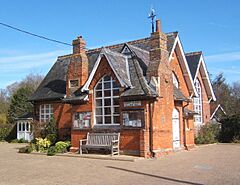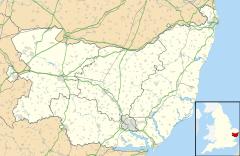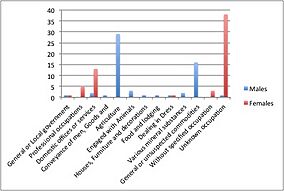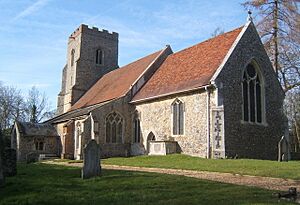Brent Eleigh facts for kids
Quick facts for kids Brent Eleigh |
|
|---|---|
 Brent Eleigh village hall |
|
| Area | 6.55 km2 (2.53 sq mi) |
| Population | 174 (2011) |
| • Density | 27/km2 (70/sq mi) |
| District |
|
| Shire county | |
| Region | |
| Country | England |
| Sovereign state | United Kingdom |
| Post town | Sudbury |
| Postcode district | CO10 |
| EU Parliament | East of England |
Brent Eleigh is a small village in Suffolk, England. It's located in the Babergh area, between the towns of Hadleigh and Lavenham. In 2011, about 174 people lived there.
The name "Brent Eleigh" might mean "Ilega's meadow that was burnt." The village is very old and was even mentioned in the Domesday Book way back in 1086! Back then, Brent Eleigh and its neighbour, Monks Eleigh, had a total of 61 people.
Contents
Village History
The Brent Eleigh Manor, a large estate, was first owned by the Illeigh/Ely family. Later, in the 1200s, the Shelton family took over. In 1607, Samuel Colman bought the manor. His family then had a long connection with the village. His son, Thomas Colman, became the vicar (a church leader) in 1625.
In the 1870s, people described Brent Eleigh's church as having old Norman (early English) parts and a newer tower. The village used to have a market, which means it was a busy trading spot!
The name "Brent Eleigh" comes from two old words. Brende means "burnt" in Middle English, and lēah means "a forest" in Old English.
Long ago, Brent Eleigh was not just a market town. It was also one of the "cloth villages." This meant that merchants from Lavenham would send wool here for people to spin into thread. In 1961, amazing 14th-century paintings were found on a wall inside St Mary's Church. These paintings became a very important discovery for Suffolk.
Jobs in the Past
The types of jobs people had in Brent Eleigh were quite different in 1881 compared to today. Many women's jobs were not recorded. However, more women worked in professional roles, like medical services or as schoolteachers, than men. More women also worked in homes as servants. In 1881, most people in Brent Eleigh worked in farming. This was because the village was in a rural area.
In 1831, there were 290 people in the village. The most common job was "labourer and servant," with 51 people doing this work. These jobs needed basic skills.
By 2011, things had changed a lot. The most common jobs were "Managers, Directors, and Senior Officials," with 23 people in these roles. In total, 79 people aged 16 to 74 had jobs in Brent Eleigh in 2011. This included 34 women and 45 men. More women now work in management roles, which is a big change from 1881 when many worked as domestic servants.
How the Population Changed
Brent Eleigh is a small village, so its population has never been huge. In 1801, there were 243 residents. This number dropped to 174 in 2011. The population has gone up and down over the last two centuries. It was highest in 1821 with 298 people. It was lowest in 1961 with 134 residents.
Between 1911 and 1921, the population dropped from 223 to 168. This was during World War I, which likely caused many people to leave or not return.
Village Location
Brent Eleigh is located along the A1141 road. The River Brett also runs nearby, flowing towards other villages like Chelsworth. If you compare old maps from the 1800s to newer ones, you'll see that the village hasn't changed much. It has kept its traditional English rural feel.
Getting Around
Because Brent Eleigh is a rural village, public transport can be limited. The closest train station is in Sudbury, which is about 11 kilometers (6.96 miles) away.
Many people in the village own cars. There are 125 cars and vans registered there. This is because there isn't much public transport nearby, so people need their own vehicles to get around. There is a bus service that goes from Hadleigh to Sudbury and stops in Brent Eleigh. However, it doesn't run very often, so you can't always rely on it.
Interesting Places to See
Brent Eleigh Hall
We don't know much about the very early history of Brent Eleigh Hall. But today, it looks like a Georgian-style building. A famous architect named Sir Edwin Lutyens designed its impressive doorway in 1933–34. This doorway is one of the special features of the Hall.
Inside the Hall's grounds, there's a beautiful Victorian walled kitchen garden. It's almost two acres big and needs some care to bring it back to life! The Hall is located north of the village, near St Mary's Church. It's a listed building, which means it's protected because of its historical importance.
A painting of Richard Colman used to be at Brent Eleigh Hall. It was later given to the Tate museum in 1997. The Colman family's connection to the Hall ended in 1739. Later, the Goates and then the Browns owned it. In 1922, the Barran family bought the estate.
During World War II, Sir Connop Guthrie Bt and his family lived in the Hall. The US Air Force, who were based at Lavenham Airfield nearby, used the Hall as a landmark because of its unique color. They even called it the "Peppermint Palace"! It's also said that the Brent Oil Field was named after Brent Eleigh because Sir David Barran, who lived at the Hall, was the Chairman of Shell UK. After Lady Barran passed away, the Hall was empty until 2015. Since then, it has been undergoing a big restoration project.
St Mary's Church
St Mary's Church was built in the 1200s. It became famous in 1961 when amazing 14th-century wall paintings were found inside. These paintings are very special. In the middle, there's a painting of the crucifixion. It's a wonderful example of medieval folk art and one of the most powerful old images in Suffolk. Next to it is a painting of the "Harrowing of Hell," which is a scene often seen in older churches.
The church is on Hall Road, just off the main A1141 road. Outside, it has Victorian windows. Inside, the sanctuary (the holy part of the church) has "three-sided communion rails." These are quite rare in East Anglia.
Sadly, the church's wall paintings were damaged by vandals in late 2016. But luckily, they have since been beautifully restored by expert conservation specialists from the UK.
Images for kids






